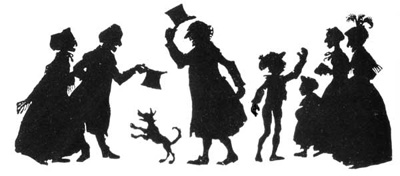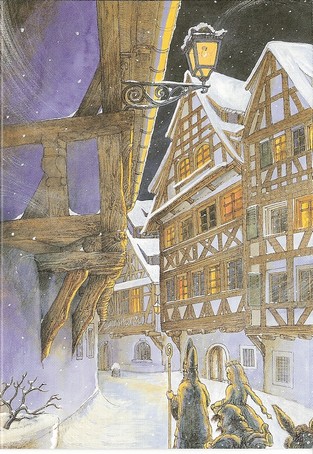|
In 1843 Charles Dickens published a simple novella titled, 'A Christmas Carol'. This story is now synonymous with Christmas tradition and quintessential to what we feel as we approach midwinter. Dicken's central character Ebenezer Scrooge is seen as a metaphorical allegory to ourselves, his character helps us question whether we have become too hardened by life. This simple yet intricate story asks us to look beyond our past pain and material interests, to look beyond commercialism and recognize the true spirit of the season.
 |
| Charles Dickens, A Christmas Carol, Illustrated by John Leech 1843 |
 |
| Marley's ghost, by John Leech. London: Chapman & Hall, 1843. First edition. |
Ebenezer Scrooge at the beginning of this tale is a miserable old man, who in his age has become a hermit and refuses to see beyond his own tight material existence. He forces his office worker Bob Cratchit to work long greuling hours with minimal pay. He refuses an invitation to his Nephews christmas dinner and sneers at a set of charity workers collecting money for the poor, referring christmas as a 'Humbug'. This term has coincidentally become what modern people say when brushing off holiday tradition. Scrooge is soon met by his partner in life who has died and comes to him as a ghost. His Partner Jacob Marley who is seven years dead carries a a long heavy chain that is wrapped over his shoulders and drags behind. It's length, link by link made of padlocks, money-boxes and keys. It is described by Marley as his own greed, chains that he established by exploiting the poor and dwelling on his own profit. He is deeply grieved and his punishment for his inhumanity is to walk the earth witnessing souls in torment, whom he has no power to help. He scolds Ebenezer that charity and mercy should have been his business and warns that on this very Christmas Eve he will be visited by three ghosts, for his time is almost too late. Scrooge draws close to a future that matches his late partner.
 |
| Jacob Marley, Arthur Rackham 1915 |
The first ghost that comes to Scrooge is called the Ghost of Christmas Past. This ghost appears as an angelic apparition, emitting light like the wick of a candle. This androgynous figure has no determinable age and carries a cap that resembles a candle extinguisher. This ghost takes Scrooge on a voyage to his past, experiencing his history of relationships and the choices he made that led him to his cold and private life. After seeing his father's neglect and later watching his younger self walk away from the only woman he ever loved he begs the ghost to see no more.
 |
| "The Ghost of Christmas Past "by P.J.Lynch (2006) |
"These are the shadows of things that have been. That they are what they are, do not blame me!"
 |
| Sol Eytinge Jr's, "Spirit of Christmas Past" (1868) |
The ghost responds before Scrooge takes the it's cap and extinguishes the light. There after he finds himself back in his bedroom where the clock has not advanced.
 |
| John Leech, 1843 |
The second ghost is called the Ghost of Christmas Present. This ghost closely resembles Father Christmas.
 |
| John Leech, 1843 |
'When he first appears before Scrooge, he invites him to "come in and know me better, man." According to Dickens' novel, the Ghost of Christmas Present appears to Scrooge as "a jolly giant" with dark brown curls. He wears a fur-lined green robe and on his head a holly wreath set with shining icicles. He carries a large torch, made to resemble a cornucopia, and appears accompanied by a great feast. He states that he has had "more than eighteen hundred" brothers and later reveals the ability to change his size to fit into any space. He also bears a scabbard with no sword in it, a representation of peace on Earth and good will toward men.' ---Wikipedia
 |
| "The Ghost of Christmas Present "by P.J.Lynch (2006) |
This spirit can fly and change shapes allowing himself to see anything and everything, he at first towers above Ebenezer. Perhaps this depiction enhanced our own modern perception of St. Nicolaus. This ghost takes Scrooge all over London to witness festivity and deprivation, in these visions Scrooge is given an intimate chance to see how his actions affect the world around him, predominately with his underpaid clerk Bob Cratchit. After a long journey the ghost pulls aside his robes to reveal two emaciated children clinging underneath. Scrooge is immediately disgusted by their appearance. The ghost names the boy Ignorance and the girl Want.
 |
| McLoughlin Bros. 1896 |
"Beware them both, and all of their degree, but most of all beware this boy, for on his brow I see that written which is Doom, unless the writing be erased."
 |
| Sol Eytinge Jr's, "Ignorance & Want" (1868) |
At the end of his visit, this ghost has aged significantly explaining to Ebenezer that he can only exist on the earth for one night, he leaves at the stroke of midnight.
The third and final ghost is the Ghost of Christmas Yet to Come, his entrance is through an ominous rolling mist.
"The Phantom slowly, gravely, silently approached. When it came near him, Scrooge bent down upon his knee; for in the very air through which this Spirit moved it seemed to scatter gloom and mystery. It was shrouded in a deep black garment, which concealed its head, its face, its form, and left nothing of it visible save one outstretched hand. ... It thrilled him [Scrooge] with a vague uncertain horror, to know that behind the mask there were eyes staring at him."
 |
| 'In the Churchyard', Sol Eytinge (1868) |
Scrooge is most haunted by this ghost, who points out the results of his selfishness. He is allowed to witness what the world becomes when he is gone and his absence is not missed. Finally in viewing his own lifeless body he is shaken to the core.
 |
| "The Ghost of Christmas Yet to Come "by P.J.Lynch (2006) |
"Good Spirit," he pursued, as down upon the ground he fell before it: "Your nature intercedes for me, and pities me. Assure me that I yet may change these shadows you have shown me, by an altered life!"
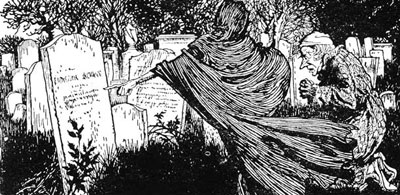 |
| Arthur Rackham, 1915 |
After the final spirit's departure Scrooge is given his second chance, he awakens to Christmas Day with a new heart. Like child he dances through the streets and sets out to positively effect everyone who crosses his path. He immediately corrects his behavior with his clerk, his nephew, and most significantly his previous lack of charity.
 |
| John Leech. London: Chapman & Hall, 1843. |
“I will honour Christmas in my heart, and try to keep it all the year. I will live in the Past, the Present, and the Future. The Spirits of all Three shall strive within me. I will not shut out the lessons that they teach!”
“It is a fair, even-handed, noble adjustment of things, that while there is infection in disease and sorrow, there is nothing in the world so irresistibly contagious as laughter and good humour.”
― Charles Dickens, A Christmas Carol
In reading Charles Dickens immortal classic we are inspired by it's simple lessons. Do not take life for granted, for you are not immortal. Have a charitable heart, your actions could very well change another's
destiny. Hold space for the spirit of Christmas, a time that asks us to view one another with our hearts and with gratitude.
Ebenezer's experience is perhaps allegorical, for many cultures throughout history anticipate that arrival of various spirits on Christmas. Ebenezer's ghostly partner, Jacob Marley, who comes dragging heavy chains and deathly apparitions is not unlike
Krampus the Christmas Devil.
The Ghost of Christmas Yet to Come also bares similar traits to the
Krampus.
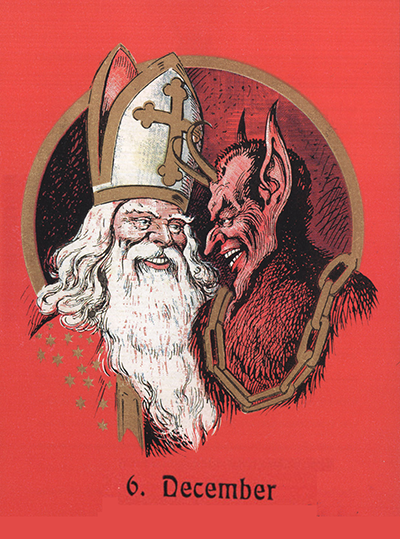 |
| Classic German depiction of St. Nicolaus & Krampus on a greeting card. |
Traditional Christmas myths and practices in Austria and Northern Italy recognize a partner akin to St. Nicolaus. He is called
Krampus the Christmas Devil. He is seen as many things, a dark and mysterious gentleman, a hairy beast or simply a devil. In Alpine Folk legend he partners with St. Nicolaus and receives the naughty children. These children are frightened by this devilish figure who brings hellish visions.
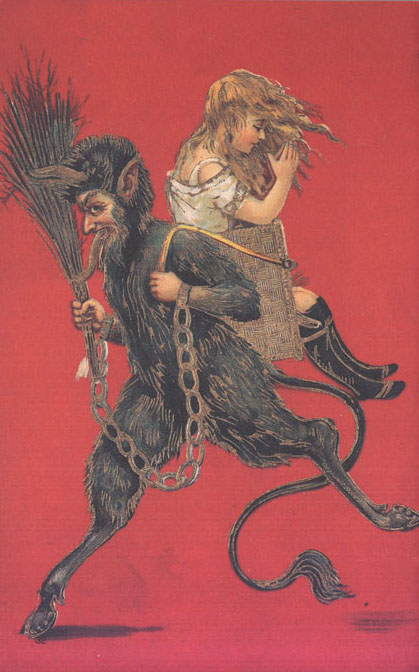 |
| Krampus & Naughty Child |
Anthropologically
Krampus has been lost in antiquity, transformed into the coal that is left in the stockings of naughty children. The origins of this devil are unknown, but pre-date Christianity. He is perhaps a variation on the old world god called
Pan. Traditional parades in Germany still feature
Krampus, a beastly devil dragging chains to frighten children into behaving. Jacob Marley's chain conjures a similar warning for Scrooge.
 |
| 'Greeting from the Krampus', a greeting card from the early 1900's. |
As an androgynous figure the ghost of Christmas Past bares resemblance to many other holiday saints.
Christkindl is another angelic figure who comes during Christmas and is celebrated by old German tradition.
Christkindl is considered an emissary from heaven, sometimes even the infant Christ himself. He is also called
'The Good Child'. He comes baring toys and treats, similar to St. Nicolaus, although...
 |
| 'The Christ-Child & St. Nicolaus', Paul Hey (1867- 1952) |
"[H]e is not the one who comes down the chimney. He is assisted by a young teenager wearing a crown of candles and dressed in white, and a boogeyman called Hans Trapp or Ruppelz. One hands out presents and candy, the other dishes out smacks and chastisements. For children who have misbehaved, the supreme punishment is to be hoisted into the wicker basket that the ogre carries on his back." (Edouard Brasey,
Faeries and Demons)
 |
| Hans Trapp, Father Whipper Vintage Card |
Hans Trapp is not unlike the
Krampus.
Christkindl like Santa Claus will not come to children who are waiting up, traditionally he must preform his gift giving as the children sleep. In many European cultures 'The Christ Child' is still celebrated as the one who brings gifts on Christmas.
 |
'Christkindel and Hans Trapp, in the Christmas Night' (Alpine tradition). Created by Schüler, published on L'Illustration, Journal Universel, Paris, 1858
Considering that Dickens ghost of Christmas Past emits a glow and can fly through the night perhaps this androgynous figure is an evolution of the Christkindl, who bares the light of heaven and at times is depicted with wings. Many other countries see the flight of various figures in Christmas folk tradition.
Italy has Befana, a kindly witch who flies upon a broom, gifting good children presents and naughty children coal.
Russia and Ukraine share Kolyada, an elfish maiden who robes herself in white. She flies by the night traveling with a sophisticated sleigh and horse, delivering presents to children. Much like Santa there are Christmas Carols to honor her.
It seems there are many ghosts and apparitions of Christmas Past, and while they drift into antiquity we see them evolve in our own traditions. Our very own St. Nicolaus is not unlike the Befana, and his companions Christkindl and the Krampus. They carry the message that Christmas is a time for spirits, a time of ghostly tales, and above all, 'magic'. And may the light of that festive winter candle never subside.
*Pictures Above By: Pauline Ellison
Source Material:
- The Enchanted World Series: The Book of Christmas, Time Life Books 1980
- Faeries and Demons and other Magical Creatures, Edouard Brasey, Barnes and Noble Books 2003
- Wikipedia.com
- Krampus.com
- Pinterest.com
- 'A Christmas Carol', Charles Dickens 1843/ Arthur Rackham 1915
|


















